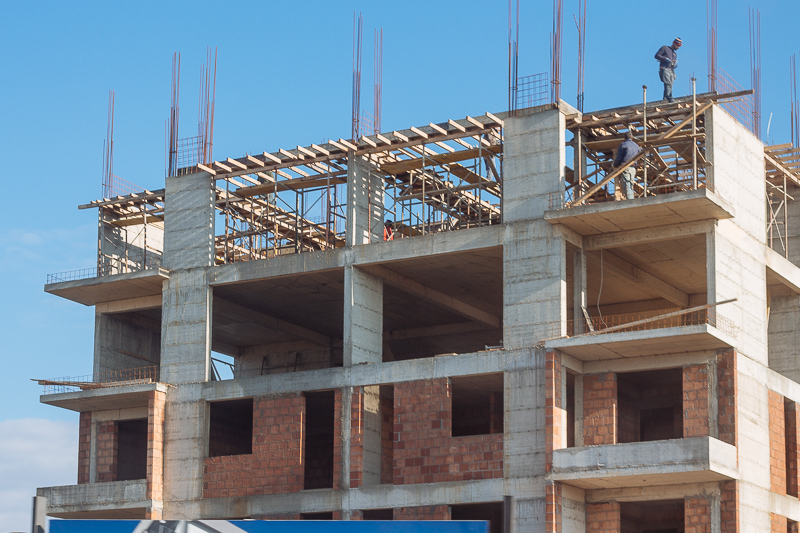I doubt this is the usual overlander/traveller blog topic! Nevertheless, as one travels through the countries that we have on Fromeward Bound there’s no doubting the influence that concrete has in shaping the region.
It should be noted that I’m a big fan of concrete; both as a building material and also aesthetically. I particularly love 1960s brutalism; as a child I would visit my uncle who lived in the Barbican and marvel at this unapologetic beast of a structure. (I’m no snob though, as I’m equally enamoured by car parks!) I love the rawness of the material, the colour palette, the different textures; it’s uncompromisingly scale and it’s innate strength. I’ve mixed concrete only once before when Captain and I laid some foundations for an extension. It’s pretty mind boggling that from four simple ingredients of sand, cement, aggregate and water one can create a material so hard and strong it can withstand a nuclear bomb.
In Eastern Russia and in Central Asia houses were (and many still are) traditionally constructed from materials eked from the surrounding area. Cabins made from local timber; gers covered in horse hair blankets; houses built from chiselled stone; roofs constructed from flattened metal barrels; bricks of straw and dung and shelters from recycled shipping containers. They have a sense of place. You can literally look at the building and it’s surroundings and see from whence the materials came. Not only are these buildings at one with their local environment they also have a sense of community. Each house would have been constructed by hand by a family as the family home.

Practically speaking, without large lifting machinery, these building materials have to be of a human dimension. They need to be forged, carried and lifted. Trees dictate the length and width of wooden planks; the dimension of moulds dictate that of bricks; the weight of stone blocks dictate their size; horse and trailers dictate the size of packable gers and yurts. The reach of the human arm dictates the internal space. These constraints therefore force one to build to scale. Buildings are quite literally human size.
What makes the new material on the block, concrete, so powerful turns out to be its weakness too. For in the quest for cheap fast development there is no competition – concrete will always win. So instead of building traditional housing – huge, unsightly apartment blocks have sprung up everywhere. This is particularly apparent in the cities; Mongolia’s capital Ulanbaataar is awash with concrete, but equally the towns and villages are also being filled in with these large blocks of concrete. They tower over the old traditional houses; domineering the skyline and bullying the townsfolk into submission.
What I love about concrete – it’s honesty as a building material – is never celebrated. Rather it’s very charm is whitewashed over with butterscotch emulsion. Like blocks of ice cream, they stand painted in hues of dusty pinks, magnolias and creams. Balustrades and ornamentations once hand carved are now produced in crass moulds. Shapes fashioned, and the corresponding spaces formed, have no limitations from the building materials used. The textures and natural anomalies of concrete are smoothed over to create a flat banal surface. Architectural designs for concrete buildings have very few build limitations and therefore design, and indeed taste, have few constraints.
We’ve created a concrete monster.
We’re in danger of living in a world where scale is lost. Where craftsmanship is lost. Where tradition is lost. Where identity is lost. Where architectural prowess is lost. A world where concrete itself is lost.
A couple of aside notes:
For those who want to watch a hauntingly beautiful, yet totally depressing, film about the impact that mining for construction materials has – you must watch Behemoth by Chinese director Liang Zhao.
Also, check out this site with information about the concrete Socialist monuments in the former Yugoslavia region. (We had planned to visit them all but unfortunately due to time constraints we’ll have to save that for another road trip).
And this site celebrating 1960s brutalism.



Lovely piece old girl. Tis a shame how mundanely it is used on the whole. Its not all bad news though…
https://www.dezeen.com/tag/concrete/
You would have given a significant part of your anatomy to get in on the 20th century tour round the oxford colleges. Get yourself a copy of this:
http://c20society.org.uk/journals/journal-11-oxford-and-cambridge/
XX
Thanks! I shall look those up. See you soon 🙂
Quite partial to a bit of concrete myself, though I confess in my professional life I didn’t employee it that often. Are you familiar with a film called Locke? It’s a movie about a concrete pour. Matthew tells me it’s actually about the complexities of human relationships but at the end of the day I was left wondering what had happened with the concrete pour rather than whether the protagonist had reconciled with his wife. Kxx
No I’ve not seen that film…I shall look it up.
Wow, I’ve never thought about concrete so deeply!
Ha ha!